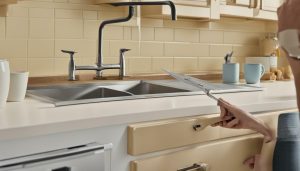Are you frustrated with low water pressure in your kitchen sink? It can be a major inconvenience, making it difficult to wash dishes or fill a pot with water. Fortunately, there are several steps you can take to address this issue and optimize your kitchen sink’s water pressure.
Key Takeaways
- Low water pressure in your kitchen sink can be caused by a variety of factors, including obstructions in the water supply, faucet aerator blockages, and issues with the plumbing system.
- It’s important to check for potential blockages and examine the water pressure regulator and supply valve to pinpoint and resolve the problem.
- If all else fails, it may be necessary to seek professional assistance to diagnose and address persistent water pressure issues in your kitchen sink.
Understanding Water Pressure Issues in Your Kitchen Sink
Having low water pressure in your kitchen sink can be frustrating and limit your ability to carry out daily tasks like washing dishes, vegetables, or filling pots. Understanding the causes of kitchen sink water pressure problems is vital in fixing them adequately.
The most common cause of low water pressure in the kitchen sink is an obstruction in the water supply. It could be debris, sediment or mineral build-up in the supply line, preventing water from flowing freely. Another reason could be a clogged aerator, which is the small screen located at the end of the faucet.
Troubleshooting kitchen sink water pressure requires understanding the specific issue affecting your sink. In some cases, it may require straightforward solutions like cleaning the aerator or removing any obstructions that may be present. In other instances, it may require professional assistance to fix low water pressure in the kitchen sink adequately.
Checking for Obstructions in the Water Supply
Low water pressure in the kitchen sink can often be attributed to obstructions in the water supply. These obstructions can occur as a result of debris from the municipal water supply, or build-up caused by hard water.
To check for obstructions in the water supply, start by turning off the main water valve that supplies water to your home. Once the valve is shut off, remove the aerator from the kitchen sink faucet by unscrewing it counter-clockwise. Rinse the aerator thoroughly in a bowl of warm water to remove any debris or mineral build-up.
If the aerator appears clean, use a flashlight to inspect the faucet for any debris or obstructions. If debris is present, use a small brush to gently remove it. If the faucet itself appears clean, proceed to check the water supply pipes.
Inspect the water supply pipes for any visible kinks or bends, as these can restrict water flow and cause low water pressure in the kitchen sink. If you notice any issues with the pipes, it’s best to call a professional plumber to make the necessary repairs.
To prevent future obstructions in the water supply, you can install a whole-house water filter to trap sediment and debris before it enters your home’s plumbing system. This can help improve water pressure not only in the kitchen sink, but throughout your entire home.
Tip: It’s important not to force any debris out of the faucet or supply pipes, as this can cause damage to your plumbing system. If you’re unsure about how to proceed or suspect a serious blockage, it’s best to call a professional plumber.
Checking the Faucet Aerators
One of the most common causes of low water pressure in the kitchen sink is a clogged faucet aerator. Over time, debris and mineral deposits can accumulate in the aerator, blocking water flow and reducing water pressure. Fortunately, checking and cleaning the aerator is a simple process that can be done without professional assistance.
How to Check the Faucet Aerators
Follow these steps to check the faucet aerators:
- Turn off the water supply to the sink.
- Unscrew the aerator from the end of the faucet spout.
- Inspect the aerator for any visible debris or mineral buildup.
- If the aerator is clogged, use a brush or toothbrush to gently scrub away any debris or buildup.
How to Clean the Faucet Aerators
If the aerator is heavily clogged, it may need to be cleaned more thoroughly. Here’s how to do it:
- Disassemble the aerator by removing the individual parts.
- Soak the parts in vinegar or a descaling solution for a few hours.
- Use a brush or toothbrush to scrub away any remaining debris or mineral buildup.
- Rinse the parts thoroughly with water and reassemble the aerator.
Once the aerator is clean, reattach it to the end of the faucet spout and turn on the water supply. You should notice an improvement in water flow and pressure.
Checking and cleaning the faucet aerators is a quick and easy way to improve water flow and enhance water pressure in the kitchen sink. Consider doing it regularly, every few months, to prevent clogs from building up and affecting water pressure.
Examining the Water Pressure Regulator
If checking for obstructions and cleaning the faucet aerators didn’t improve the water pressure in your kitchen sink, it may be time to examine the water pressure regulator. The regulator is responsible for controlling the water pressure that enters your home, including the pressure that flows through your kitchen sink faucet. If the regulator is not functioning correctly, it can cause low water pressure or even a complete loss of water flow.
To examine the water pressure regulator, locate the main water shut-off valve, which is typically found near the water meter or where the main water supply enters your home. Turn off the water supply and unscrew the cap on the regulator. The regulator typically has a spring and an adjusting screw that controls the water pressure. If the spring is damaged or the adjusting screw is not set correctly, it can cause low water pressure.
Some water pressure regulators may need to be replaced if they are malfunctioning. If you are unsure about how to proceed, it may be best to seek the assistance of a professional plumber to diagnose and repair any issues.
Troubleshooting the Water Pressure Regulator
If the pressure regulator appears to be functioning correctly, there are a few additional troubleshooting steps you can take before seeking professional assistance. First, check to make sure that the pressure reducing valve (PRV) is installed and functioning correctly. The PRV is located on the water line and is responsible for reducing the pressure of the water entering your home to a safe level. If the PRV is not working properly, it can cause low water pressure.
If the PRV is installed and working correctly, you may need to check the water pressure gauge to ensure that your water pressure is within normal range. The ideal range for household water pressure is between 45 and 60 psi. If the pressure is outside of this range, it may be necessary to adjust the regulator or replace it entirely.
Remember, if you are unsure about any of these steps or if low water pressure is a persistent problem, it is always best to seek the assistance of a professional plumber who can diagnose and repair any issues related to your kitchen sink water pressure.
Inspecting the Supply Valve and Pipes
Another potential cause of low water pressure in the kitchen sink could be issues with the supply valve and pipes. The supply valve controls the flow of water to your home, and any issues with it can impact water pressure in the sink.
Start by checking if the supply valve is fully open. If it isn’t, turn it counterclockwise to open it fully and see if this resolves the issue. If the valve is already fully open, the problem could be due to the pipes.
Inspect the pipes for any signs of damage or corrosion that could be causing blockages and restricting water flow. You can do this by examining visible pipes and checking for leaks, rust, or discoloration. If you notice any of these signs, it may be necessary to replace the damaged pipes to improve water pressure in the kitchen sink.
If you’re unsure about inspecting and replacing pipes on your own, it’s best to seek the assistance of a professional plumber to ensure the job is done correctly and safely.
SEO relevant keywords: fix low water pressure in kitchen sink
Addressing Potential Pipe Blockages
If you have checked your water supply, faucet aerators, water pressure regulator, and supply valve and pipes, but you still experience low water pressure in your kitchen sink, there may be blockages in your pipes. Pipe blockages can be caused by a variety of things, including mineral buildup, debris, and grease.
To address potential pipe blockages and increase water pressure in your kitchen sink, follow these tips:
- Flush the pipes: Turn off your kitchen sink’s water supply and open all of the other faucets in your home. Let the water run for a few minutes to flush out any debris or mineral buildup in your pipes.
- Clean the pipes: If flushing the pipes doesn’t help, try cleaning them. You can use a commercial pipe cleaner or create your own mixture of equal parts baking soda and vinegar. Pour the mixture down the drain and let it sit for a few hours before flushing the pipes again with hot water.
- Remove and clean the P-trap: The P-trap is a U-shaped pipe beneath your sink that can become clogged with debris. Place a bucket beneath the P-trap to catch any water, then remove the trap and clean it out before reattaching it.
By following these tips, you can address potential pipe blockages and increase water pressure in your kitchen sink. However, if you’re still experiencing low water pressure, it may be time to seek professional assistance.
Checking for Pressure Loss in the Main Water Supply
If you’ve tried all the tips discussed above and still have low water pressure in your kitchen sink, the problem may lie in the main water supply. Insufficient water pressure in the main supply line can impact the water pressure throughout your house, including the kitchen sink.
To check for pressure loss in the main water supply, you can use a pressure gauge, which can be purchased at a hardware store. First, close all of the faucets in your house, including the kitchen sink. Then, screw on the pressure gauge to an outdoor hose spigot. Turn on the water and read the pressure gauge reading. Typically, the pressure reading should be between 45 and 55 PSI (pounds per square inch). If the reading is lower than 40 PSI, there may be a pressure loss in the main water supply.
If you suspect pressure loss, contact your water supplier or a licensed plumber to investigate and resolve the issue. This type of problem can be caused by a variety of factors such as a buildup of sediment in the water main, a break or leak in the main supply line, or an issue with a pressure regulator. A professional plumber will be able to diagnose the problem and fix it in a safe and efficient manner.
It’s important to address any water pressure issues in your kitchen sink quickly, as low water pressure can cause problems in daily activities such as washing dishes or preparing food. With the right techniques and resources, you can improve the water pressure in your kitchen sink and enjoy a more functional and efficient kitchen.
Considering the Age of Plumbing System
The age of your plumbing system can also affect water flow in your kitchen sink. Over time, pipes can become corroded or damaged, leading to leaks or slow water pressure. If your house has an older plumbing system, it may be time to consider upgrading to new pipes to improve water flow and pressure in your kitchen sink.
If you’re not sure about the age of your plumbing system, you can check the pipes yourself or hire a professional plumber to do an inspection. Depending on the condition of your pipes, you may need to replace all of them or just a portion of them. In either case, upgrading your plumbing system is a long-term investment that can benefit your home’s overall water flow and pressure, as well as prevent costly water leaks and damage.
SEO keywords: improve water flow in kitchen sink, kitchen sink water pressure problems
Seeking Professional Assistance
If you have tried all the troubleshooting steps mentioned above and are still experiencing low water pressure in your kitchen sink, it may be time to seek professional assistance.
A licensed plumber can diagnose the root cause of the issue and recommend the appropriate solution. This may involve replacing old pipes or removing blockages that are affecting water flow.
It is important to address low water pressure issues promptly, as they can lead to significant water waste and make tasks such as dishwashing and cooking more difficult and time-consuming.
Don’t hesitate to contact a plumbing professional if you are unable to resolve the low water pressure issue on your own. By seeking professional assistance, you can ensure that your kitchen sink is functioning optimally and enjoy the benefits of a strong and consistent water flow.
Tips for Maintaining Good Water Pressure
Keeping your kitchen sink water pressure at an optimal level requires some maintenance and attention. Here are some tips to help you maintain good water pressure in your kitchen sink:
- Regular cleaning of faucet aerators: As discussed in section 4, clogged faucet aerators can lead to low water pressure. You can avoid this problem by cleaning the aerators regularly. Simply unscrew the aerator from the faucet and soak it in vinegar for a few hours to remove any mineral buildup.
- Prevent pipe blockages: As we discussed in section 7, blocked pipes can reduce water pressure. Avoid pouring grease or oil down the drain, and clean out any hair or other debris that might get caught in the sink trap.
- Keep an eye on the water pressure: Regularly checking your water pressure (as described in section 2) can help you catch any issues early on and prevent further damage. Ideally, the water pressure in your kitchen sink should be between 45 and 55 psi.
- Replace old plumbing: As mentioned in section 9, old or corroded plumbing can reduce water pressure. Consider replacing old pipes or fixtures if you notice a consistent decrease in water pressure.
- Seek professional help: If you are experiencing persistent water pressure issues that are not resolved by the above tips, it may be time to call in a professional plumber. They can help diagnose and fix any underlying issues with your plumbing system.
By following these tips, you can maintain good water pressure in your kitchen sink and avoid any potential issues down the line.
Conclusion:
Improving water pressure in your kitchen sink is crucial for optimizing its performance and ensuring the smooth functioning of your household. By understanding the potential causes of low water pressure and following the troubleshooting steps outlined in this guide, you can address these issues and enhance water pressure and flow in your kitchen sink.
Remember to start by checking for any obstructions in the water supply or clogged faucet aerators, and proceed with examining the water pressure regulator and inspecting the pipes and supply valve. If necessary, address potential pipe blockages or pressure loss in the main water supply. Additionally, consider the age of your plumbing system and seek professional assistance when necessary.
By following these tips and maintaining good water pressure in your kitchen sink, you can ensure that your household runs smoothly and efficiently. Make sure to incorporate these practices in your routine plumbing maintenance to guarantee that you always have optimal water pressure.
FAQ
Q: How can I improve water pressure in my kitchen sink?
A: There are several steps you can take to improve water pressure in your kitchen sink. Some common solutions include checking for obstructions in the water supply, cleaning faucet aerators, examining the water pressure regulator, inspecting the supply valve and pipes, addressing potential pipe blockages, checking for pressure loss in the main water supply, considering the age of your plumbing system, and seeking professional assistance if needed. Additionally, maintaining good water pressure can be achieved by following some helpful tips and best practices.
Q: What are some signs of low water pressure in a kitchen sink?
A: Some signs of low water pressure in a kitchen sink include slow or weak water flow, reduced water pressure when using multiple fixtures simultaneously, and difficulty in rinsing dishes or filling pots quickly. If you notice any of these signs, it may be an indication that you have a water pressure issue that needs to be addressed.
Q: How can I troubleshoot and fix kitchen sink water pressure problems?
A: Troubleshooting and fixing kitchen sink water pressure problems can involve various steps. Some common troubleshooting methods include checking for obstructions in the water supply, cleaning faucet aerators, examining the water pressure regulator, inspecting the supply valve and pipes, addressing potential pipe blockages, checking for pressure loss in the main water supply, considering the age of your plumbing system, and seeking professional assistance if needed. By following these steps, you can identify and resolve the underlying causes of low water pressure in your kitchen sink.
Q: What should I do if I am unable to improve water pressure in my kitchen sink?
A: If you have tried various troubleshooting methods and are still unable to improve water pressure in your kitchen sink, it may be necessary to seek professional assistance. A professional plumber will have the expertise to diagnose and resolve persistent water pressure issues effectively. They can identify any underlying problems in your plumbing system and provide appropriate solutions to restore optimal water pressure in your kitchen sink.
Q: How important is it to maintain good water pressure in a kitchen sink?
A: Maintaining good water pressure in a kitchen sink is essential for optimal performance and functionality. Adequate water pressure ensures efficient cleaning of dishes, quick filling of pots, and the ability to use multiple fixtures simultaneously without a significant drop in water pressure. By addressing and maintaining good water pressure, you can enhance the overall experience and convenience of using your kitchen sink.

It’s me, Amber Hayden, the heart and soul behind SagarmathaOnlineMedia.com. From a young age, I’ve been head over heels for everything home-related, from interior decor to gardening. I’m the type who can’t resist a well-crafted piece of furniture, and I firmly believe that a home isn’t complete without a pet or two. But it’s not just about creating pretty spaces for me. I’m all about making homes that tell a story reflecting the people living there. SagarmathaOnlineMedia.com is my way of sharing this passion with you. Whether you’re looking for tips to jazz up your living room, advice on pet care, or ideas to make your garden bloom, I’m here to help. So, let’s embark on this journey together and make your house a home!



